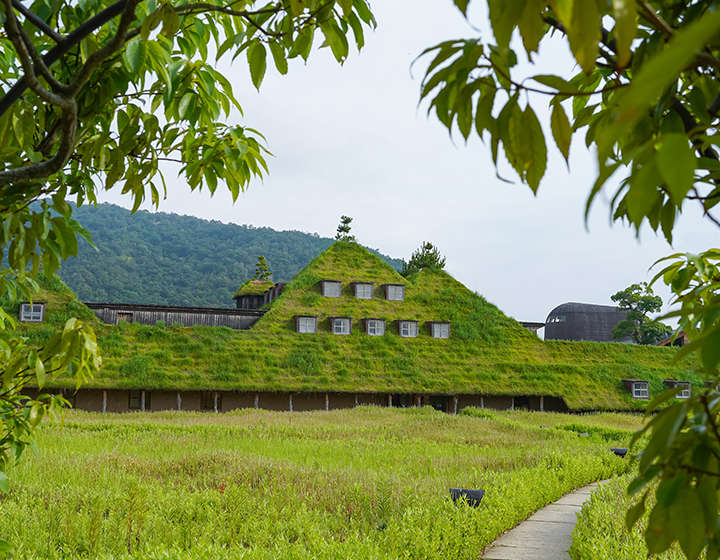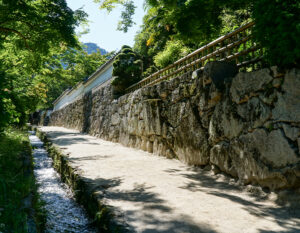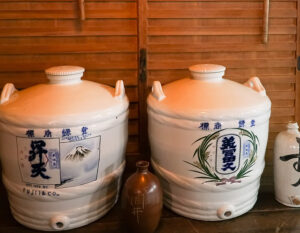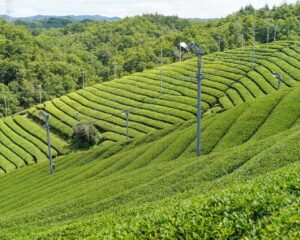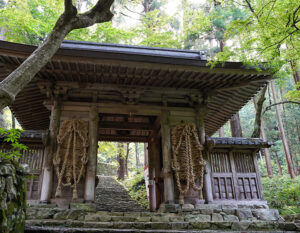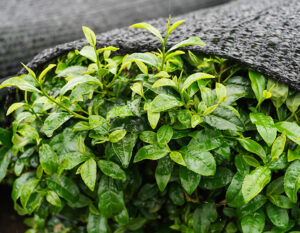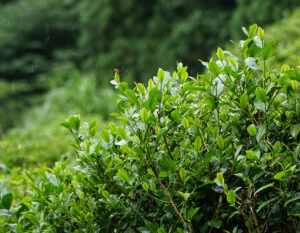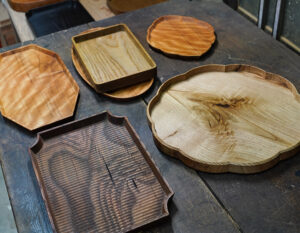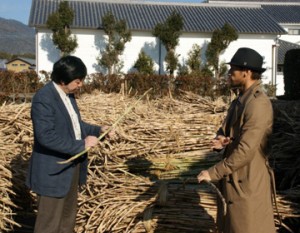While there are many well-known companies that have their roots in the Omi merchants, there may be few that are still based in Omi, despite their national recognition. We visited Masahito Yamamoto, CEO of the Taneya Group, which aims to recreate the beautiful original landscape of the surrounding water villages and greenery and to create products that “learn from nature,” and asked him about his thoughts.
From a lumber merchant to a Japanese confectionery shop. A long-established wagashiya in business for 150 years

Taneya was founded 150 years ago. Taneya began as a lumber merchant in the Edo period (1603-1867), later became involved in the sale of grain and other seeds, and started a small confectionary shop in 1872 (Meiji 5).
The company was founded in Omihachiman City, Shiga Prefecture, located on the east side of Lake Biwa. Perhaps it was the disposition of the Omi merchants who were once active in this area that led them to change the form of their business one after another in accordance with the trends of the times. Even though the products handled changed from seeds to confectionaries, the name “Taneya” remained familiar to people, and the name “Taneya” continues to be used today as an important name given to the business by the local people.
Started manufacturing Western-style confectioneries in the sixth year after the war
Taneya, which had focused on Japanese confectionery since its early days as a confectioner, began producing Western-style confectionery because of the presence of architect William Merrell Vories, who was known as “the blue-eyed Omi merchant. At that time, when Japanese-style living was still the mainstream, the Vories’ family across the street from the store would set up a table in the garden and hold tea time at 3 o’clock in the morning. Everyone worked hard during the day, but they would relax on the lawn and eat cakes and cookies. It was an unthinkable scene at the time, but as he learned about American culture through his interactions with the Vories, he realized that this might be the future, and in 1951, soon after the war, he began manufacturing western-style confectionery.
Later, the Western confectionery division became independent and “Club Harrier,” known for its baumkuchen, was born. Taneya for Japanese confectioneries and Club Harrier for Western confectioneries. The two brands established a firm foundation and stimulated each other to create the unique taste of the Taneya Group.
Confectionery production must be rooted in the community
In Omihachiman City, the traditional fire festival “Sagicho Festival” is held every year in mid-March to herald the arrival of spring. Taneya sells “Take-Yokan”, a type of take-yokan made of water yokan poured into fresh green bamboo, only during this time of year. Take-yokan is available for only two days in a year. It is certain that it would sell better if the sales period were extended, but they do not intend to do so. The confectioner’s business is backed by history, tradition, and culture. More important than their own business is to blend in with the local community. Taneya’s traditions and thoughts are reflected in the sweets that are only available at this time of the year and the sweets that are served only at this time of the year, no matter how much time and effort it takes to make them.
The youngest person to receive the “Honorary President’s Craft Culture Award” after starting out as a bag-bearer.
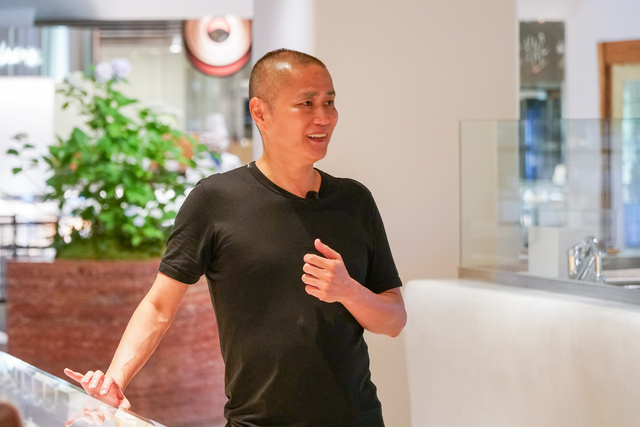
The current head of the company is Masahito Yamamoto, the 10th generation. At the age of 24, he was the youngest person ever to receive the “Honorary President’s Craft Culture Award” at the National Confectionary Exposition. Born and raised in Omi Hachiman, I have a desire to offer the local taste of Omi Hachiman to the local people and customers before I want to make sweets. Craftspeople tend to focus on pursuing their own skills, but in order to continue, it is important to be recognized by customers and to be rooted in the community. It must be good not only for the seller and the buyer, but also for the world. We always keep this in mind as we continue to make sweets,” says Yamamoto.
There is no concept of preserving the taste of the previous generation.
Surprisingly, Taneya has no intention of preserving the taste of its predecessors. Whenever a new generation takes over, all of the products are basically renewed. The amount of ingredients and the method of preparation are reviewed from the very beginning, but if a long-time customer says, “It’s the same as before,” it disqualifies him as a craftsman. He says that being told, ” It tastes just as good as before,” is proof that he is a professional.
As the world changes, confectionery must also change. For example, a decade ago, tea and water were not sold in vending machines, but now they are commonplace. As time goes by, people’s palates and demands change. Taneya’s style is to preserve what is good, of course, but to change what needs to be changed.
La Collina Omi Hachiman, a place of connection with the theme of “learning from nature
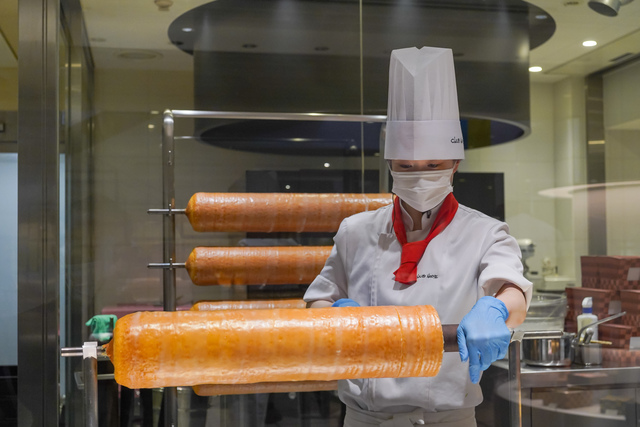
Currently, the Taneya Group has more than 40 stores nationwide. The Taneya Group is now well known outside of Shiga Prefecture and in urban areas, and Mr. Yamamoto himself has been traveling to many parts of the country.
I started to think that I wanted to do something new in my birthplace after doing business outside of the prefecture, and that’s when I decided to create La Collina Omi Hachiman. By walking around the various areas with my own feet, like the Omi merchants of the past, I began to think about what could only be done in Omi Hachiman. I began to think, “What can I do only in Omi Hachiman?
The first thing he decided on was the theme of “learning from nature. Until now, we have been using nature, but from now on, we will learn from nature as a teacher. La Collina” means “hill” in Italian. The name was given by Michele De Lucchi, a leading Italian architect, based on the image of the original landscape of gently sloping hills in this area. If the climate changes due to global warming, rice and azuki beans, which were originally grown in the area, will no longer be available. This could make it impossible to continue making confectionery. This grand vision, which began with such fears, is imbued with a desire to return to the original landscape of the land and show how “life” can be lived together by people and nature.
Various specialty stores are scattered throughout the nature-inspired forest.
The site is the size of three Koshien Gardens. In the dream of creating a large forest in 50 to 100 years, acorns were picked up, grown into saplings, and planted all over the site. He even went to a nearby riverbed to collect native weeds and transplant them.
The main store, with its triangular roof covered with grass, was designed by architect and architectural historian Terunobu Fujimori, who is known for his buildings that successfully incorporate natural materials. The building was created by the architect and architect-historian, Terunobu Fujimori, who spoke of his desire to create a place where visitors can feel the winds blowing on the land and the changing of the seasons while gazing at the mountains stretching out in the background together. The Japanese confectionery sales floor features all of the products that Taneya currently makes. Chestnut Manju,” the only confectionery that has been made since the company’s establishment, has a moist and flavorful white bean paste with chestnuts chopped into it, and the dough that wraps it is fluffy and savory. The most popular item in the confectionery corner is “Baumkuchen,” which is synonymous with Club Harrier. This is another signature product that has been on the market for over 70 years. At the time, baumkuchen was usually made with a hard dough, but Club Harrier overturned the image of baumkuchen by creating a fluffy texture to suit the palates of local people.
Other surprises and delights, such as the “Chestnut Hyakubon” sponge cake store, where you can taste “Taneya Castella,” which is as light as a cloud, and the “gift store,” which Mr. Yamamoto calls “my treasure box,” are available everywhere you go, just like at a theme park.
Candy Farm,” a confectioner’s secret base
The “Candy Farm,” the company’s own farm, is located in an area of the vast site with even more greenery. This is a secret base for the staff of the Taneya Group. Wildflowers grown at the Candy Farm are potted and sent to stores nationwide to add natural color to their storefronts.
In the fields, which they started by cultivating the soil themselves, they practice rice and vegetable cultivation without using pesticides and as much as possible by human hands. In the spring, swallows come and build nests, and duck parents and their children, who have been living there for some time, live in a natural way.
Yamamoto says that circling the site helps him organize his thoughts, and that the creation of a place where he can be in touch with nature has increased the motivation of his employees.
What Nature Taught Me
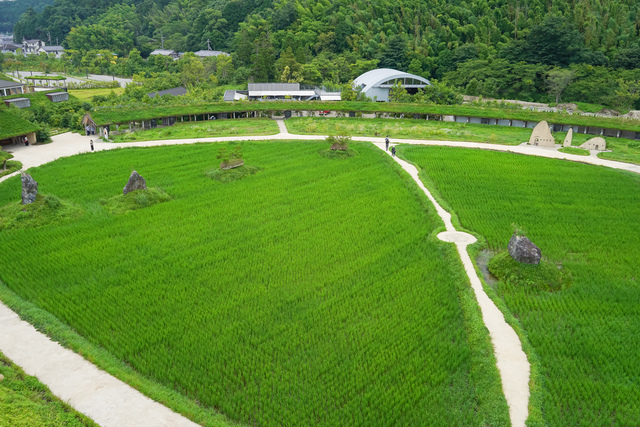
La Collina has become a major tourist attraction, attracting more than 3 million visitors a year, thanks to the popularity of its nature-based, story-like worldview.
But what Yamamoto feels was the best part of all was that he was able to learn a lot from nature. One small seedling can grow into a magnificent tree more than a person’s height in 10 years,” he said. Even after the person who planted it is gone, the tree will live on in this place, becoming part of the landscape and being passed down from generation to generation. I have learned from nature that it is better not to try to produce results only in one’s own generation, but to do things while thinking that the seeds planted in my generation will bloom in tens or hundreds of years, ” he said.
Creating products that use every grain of rice and azuki bean with care
What is important to Naneya in making products is not to waste the materials produced by farmers. Always considering the amount of time and effort required to produce a grain of rice or a grain of azuki beans, the company has a system in place whereby the parts left over from one process are utilized in another process. The company’s goal is not to make products that are “beautiful” or “sophisticated,” but rather to create products that are “tasty ” when you eat them. This is what Taneya has always valued since its establishment.
Toward a future where people and nature can live together. Taneya’s Challenge Continues
According to Mr. Yamamoto, “We are only about one-third of the way through the concept. He has always had many things he wanted to do, but now that he has turned his attention to nature, he has even more things he wants to do. He says, “I can’t do anything new if I stay in the president’s office,” and he now enjoys visiting producers and places of interest throughout Japan to listen to their stories, and then taking the ideas he gets back home to try putting them into practice. He is now looking forward to taking the ideas he gets there home and putting them into practice. I would like to learn from the flow of nature as I carry on the tradition. Mr. Yamamoto, who says this while gazing at the beautiful original landscape of Omi Hachiman, and Taneya will continue to take on new challenges in the future.



